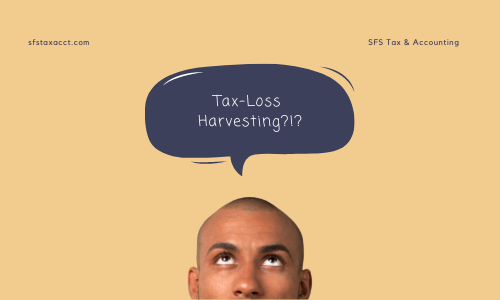Tax-loss harvesting, what the heck is that?
Simply put, it is when you sell some investments at a loss to offset gains you’ve realized by selling other stocks at a profit. The result is that you only pay taxes on your net profit or the amount you’ve gained minus the amount you lost, thereby reducing your tax bill.
Even with a strong market, you may not obtain the result you expect. However, a poor-performing investment does have an upside. You may be able to use your loss to lower your tax liability. This strategy is called tax-loss harvesting.
Here are five tips for you to consider:
Tip #1: Separate the short-term bucket from the long-term bucket
Your investments are divided into two buckets. Short-term investments are those you’ve held a year or less, and their gains are taxed as ordinary income. Long-term investments are those you’ve held more than a year, and their gains are taxed at generally lower capital gains tax rates. Thus, an objective in tax-loss harvesting is to use losses to reduce short-term gains.
Tip #2: Follow IRS netting rules
When tax-loss harvesting, use IRS netting rules on the realized gains and losses in your portfolio. Short-term losses must first offset short-term gains, while long-term losses offset long-term gains. Only after you net out each category can you use excess losses to offset other gains. Use this knowledge to your advantage to reduce your taxable income when selling investments.
Tip #3: Lower your ordinary income by $3,000
Up to $3,000 of realized capital loss can be used to reduce your taxable income in one year (if an investor’s tax-filing status is single or married filing jointly). If you still have excess losses after reducing both capital gains and ordinary income, you can carry these losses forward to use in future tax years.
Tip #4: Beware of wash sales
You cannot deduct a capital loss on the sale of a security against the capital gain of the same security. The IRS prohibits the use of tax-loss harvesting if you buy a “substantially similar” asset within 30 days before or after selling it.
Tip #5: Consider managerial costs
Tax-loss harvesting does not come without a cost in both the transaction fees and your time. Therefore, think about conducting tax-loss harvesting once a year as part of your annual tax-planning strategy.
Remember, you can turn an investment loss into a tax advantage, but only if you know the rules. Check with your Enrolled Agent and Financial Advisor.
#IRS #taxjam #taxlossharvesting #taxloss #jeffreyschneiderea #sfstaxacct #washsale


